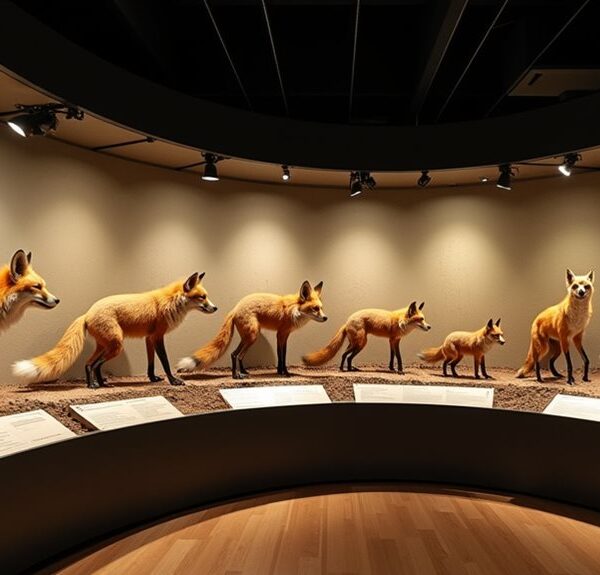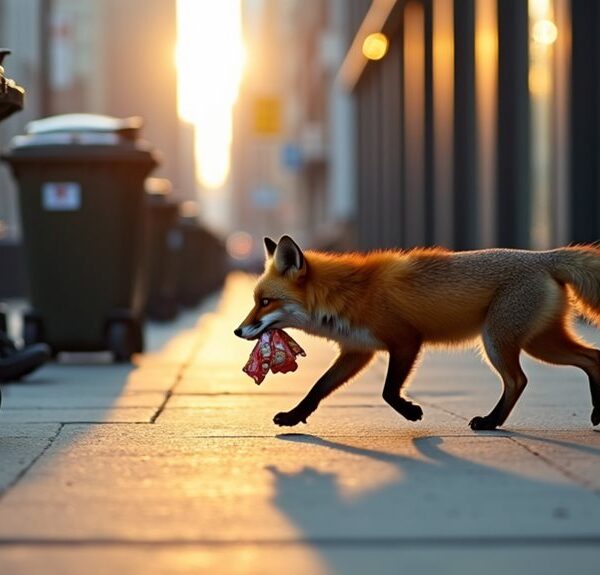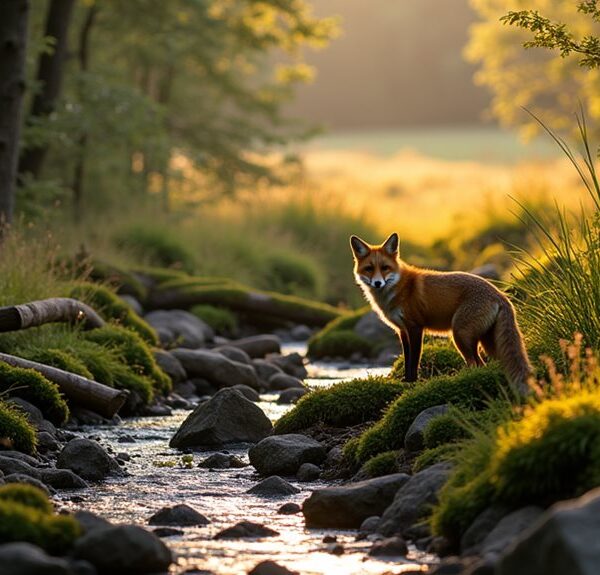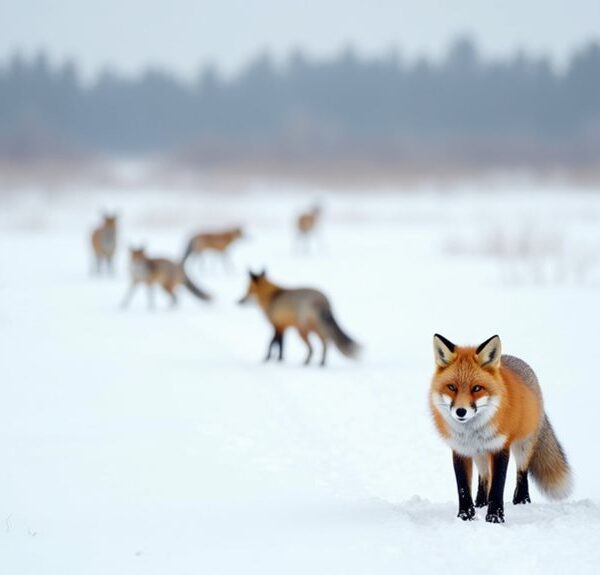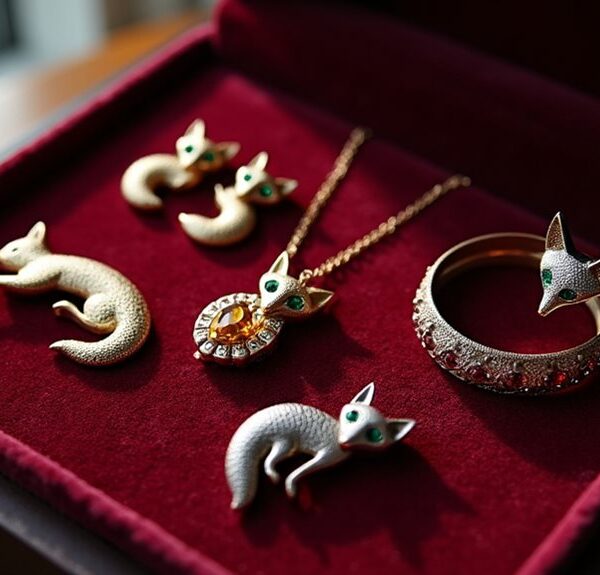Red foxes have some clever tricks up their furry sleeves to stay warm during the chilly winter months. They grow a thick undercoat that traps warmth, and their paws sport extra fur to battle icy surfaces. Curling up tight is their go-to move for keeping cozy, while finding dens or burrows helps them escape the cold winds. You might find them active at night when it's a bit milder, too! With a knack for storing food, they make sure to have extra energy for those frosty days. Stick around, and you'll discover even more about these clever critters and their chilly escapades!
Contents
Physical Adaptations for Insulation
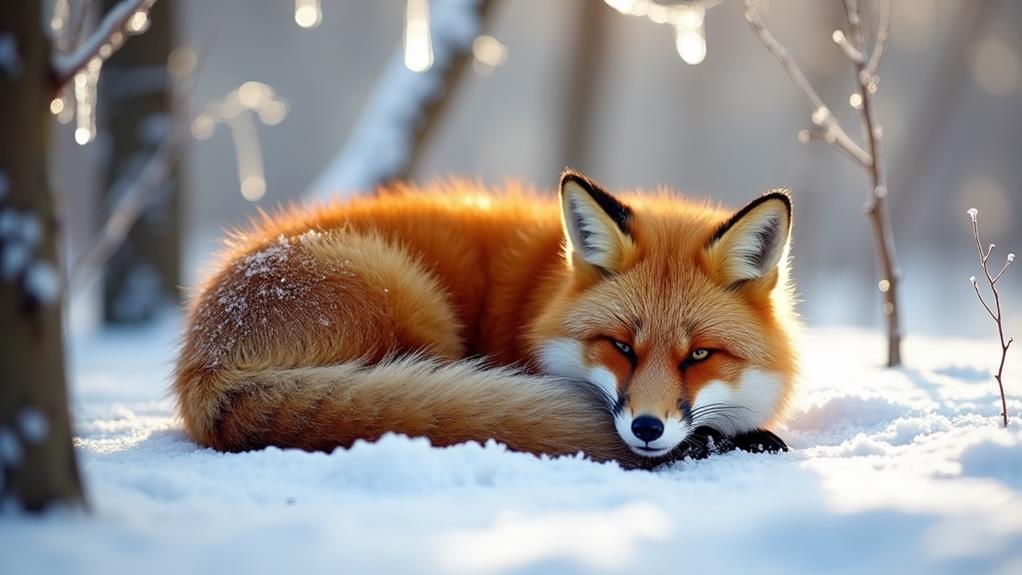
One of the most striking ways red foxes adapt physically for insulation during winter is by growing an extra-thick undercoat of fur. This fluffy layer keeps them cozy when temperatures drop, similar to the excellent insulation Arctic foxes have developed for their extreme tundra environments, which helps them survive harsh winters physical adaptations of Arctic foxes.
Isn't it incredible how nature works? Along with this deliciously thick fur, their paw pads get a makeover too, developing extra thickness that protects them from icy snow. It's like wearing a warm pair of fuzzy socks—who wouldn't want that?
Now, let's talk about those adorable little fat reserves they accumulate in the fall. These aren't just for snacking; they provide energy while also working as thermal insulation. Talk about a two-for-one deal!
Plus, red foxes use a clever heat exchange mechanism in their legs to keep warmth in check, which is just genius.
And here's a fun fact: their lower paw temperature is naturally adapted to enhance insulation against that cold ground, making it easier for them to strut around despite the winter chill.
These wonderful adaptations help red foxes thrive in harsh conditions, showcasing a perfect blend of beauty and practicality. Isn't it heartwarming to see how they've equipped themselves for survival?
Behavioral Changes in Winter
As red foxes adapt to the cold, their behavioral strategies play an essential role in surviving winter's challenges.
These clever creatures know how to stay warm and conserve energy during harsh weather, showcasing their adaptability in diverse environments, such as those found in urban and rural habitats. You'd be amazed at their smart habits that help them thrive!
Here are some behavioral adaptations red foxes use to keep cozy:
- Curling up: They curl up tightly to conserve body heat, minimizing exposure to chilly air.
- Seeking shelter: When temperatures drop, foxes stay in dens or burrows, escaping the biting wind and cold.
- Increased nocturnal activity: Foxes shift their hunting to nighttime, taking advantage of milder temperatures for foraging.
During the warmer months, these little foxes pack on some extra body fat, creating an energy reserve.
This fat not only helps keep them warm but also serves as a snack stash during those tougher winter days.
So, while the snowflakes dance outside, you can relax, knowing these smart foxes have their winter strategies all figured out.
They really know how to make it through the cold with style and smarts!
Hunting and Food Strategies

When it comes to hunting in winter, red foxes showcase their impressive skills and adaptability. These clever critters rely on their sharp hearing and sense of smell to locate small mammals like mice and voles hiding beneath the snow.
They utilize adaptations for survival that help them thrive in harsh conditions. Imagine them pouncing into the white fluff, like furry little ninjas, ready to capture their elusive prey! This pouncing technique not only boosts their hunting success but also makes for some entertaining winter performances.
To guarantee they've got enough grub, red foxes develop smart hunting and food strategies. When food gets scarce, they'll cache surplus meals by digging holes to bury and save for later. This helps red foxes survive during those lean winter days.
They're savvy eaters, relying on a steady diet of small mammals, carrion, and sometimes birds to meet their daily energy needs of about 1-2 pounds.
Additionally, red foxes shift their hunting times to twilight or nighttime, making the most of their keen senses in low-light conditions.
Isn't it impressive how these resourceful canines adapt their habits just to keep their bellies full? They truly embody the spirit of survival in a winter wonderland!
Shelter and Denning Habits
When winter really kicks in, red foxes know how to find cozy spots to hunker down.
You'll often catch them snuggling up in dens, which can be tucked away underground or hidden in thick bushes—talk about a furry fort!
These clever creatures use their dens not just to escape the freezing wind but to keep their warmth close, making it the ultimate winter retreat.
Insulation and Warmth
Keeping warm during winter is essential for red foxes, and they've developed several effective strategies to achieve this. Their thick winter coat plays a key role, providing essential insulation against the biting cold.
You'll find that these clever creatures rely on multiple methods to maintain warmth:
- An extra-thick undercoat: This helps trap heat, acting like a fluffy shield against frigid temperatures.
- Dens and sheltered areas: Red foxes seek out cozy dens, often dug into the ground or hidden in dense vegetation, to escape harsh weather.
- Insulated paws: The fur on their foot bottoms helps protect against the chill of snow and ice, making their winter strolls surprisingly graceful.
Additionally, red foxes have a cute habit of curling up when resting, conserving body heat like furry little burritos!
By providing themselves ample cover and seeking out warm spots, these resourceful animals demonstrate just how well they've adapted to winter's chill.
Den Locations and Characteristics
Red fox dens serve as essential shelter during winter, offering refuge from extreme cold and harsh winds. You might be surprised to learn that red foxes typically create their dens in underground burrows or thick vegetation.
These cozy spots keep them warm, while also hiding them from prying eyes and potential predators. You'd find these den locations often close to food sources, like small rodents, ensuring the foxes have easy access to snacks!
Most den entrances measure around 8-9 inches in diameter, just the right size for a fox to slip in and out comfortably.
Red foxes show remarkable adaptability by utilizing abandoned burrows from other animals or digging their own, proving they're quite resourceful.
While these clever creatures mostly den during the breeding season, you'll see them retreat to the safety of their dens during especially harsh winter conditions.
Shelter During Extreme Weather
As temperatures plummet and harsh winter storms roll in, red foxes seek various forms of shelter to withstand the elements. Their clever instincts lead them to cozy nooks where they can ride out extreme weather safely.
When you think about their survival tactics, consider how adaptable they really are:
- They often den under porches or in burrows, finding refuge from the biting cold and wind.
- Their dens, typically underground or nestled in dense vegetation, provide much-needed protection from harsh conditions.
- During severe storms, they'll also seek extra shelter, showing a remarkable ability to adapt.
What's fascinating is that red foxes can be found snoozing under snow blankets, which act like natural insulation!
During the mating season, their dens become an even more important space, offering a secure environment for nurturing their young.
You can see how these savvy foxes know the importance of shelter in surviving winter's toughest challenges.
Coat Development Mechanisms

When winter hits, red foxes show off some amazing coat development tricks to stay cozy.
They grow a thick undercoat that traps warmth like a fuzzy blanket, keeping them snug against the chilly air.
Plus, their legs have a neat heat exchange mechanism that helps them keep their paws warm, proving that even in the wild, a little clever engineering goes a long way!
Thick Winter Undercoat
There's no denying that red foxes are well-equipped for the winter chill, primarily thanks to their thick winter undercoat. This incredible insulation mechanism is what helps them thrive in frosty conditions. As the days get chillier, red foxes grow a cozy layer of extra-thick fur that serves as their own little heat blanket.
Their winter coat features not just longer but also denser hair, enhancing thermal protection. Here are a few highlights of how this thick winter undercoat works wonders:
- Maximizes warmth: The dense fur traps air, keeping the cold out and the heat in.
- Adapts to the chill: This undercoat grows specifically in response to winter, showcasing their adaptability.
- Insulates their paws: Even the fur on their foot bottoms helps block out the cold from snow and ice.
Thanks to this clever adaptation, red foxes maintain their body temperature and energy levels, allowing them to explore diverse and chilly habitats.
Heat Exchange Mechanism
Red foxes have developed a remarkable heat exchange mechanism within their coats that helps them thrive in frigid temperatures. When cold weather rolls in, these clever creatures grow an extra-thick undercoat of fur, acting like a cozy blanket that keeps them warm. Along with longer and denser hairs, their fur traps air efficiently—helping retain essential body heat.
But the magic doesn't stop there! You'll notice that their legs have a special setup that minimizes heat loss as they scurry around searching for snacks. This clever design is like their own built-in thermal jacket.
Oh, and let's not forget about those furry paws! Additional fur on their feet not only insulates against cold but also gives them a solid grip on slippery surfaces covered in snow and ice.
Lastly, red foxes are smart enough to bulk up on body fat during warmer months. This extra layer of insulation acts as an energy reserve, ensuring they can handle winter's chill with style and grace.
Heat Preservation Techniques
Preserving heat is essential for red foxes during the harsh winter months. To thrive in these icy conditions, they rely on several effective heat preservation techniques.
First, they grow an extra-thick undercoat of fur that acts like a cozy blanket, trapping warmth close to their bodies. Also, they accumulate extra body fat in the fall—not just for aesthetics! This fat layer serves as insulation and energy reserves, helping them stay warm when food is scarce.
Here are some of the clever ways red foxes keep that heat in:
- They develop additional fur on their paws to enhance grip and stay warm when walking in the snow.
- Their legs have a special mechanism that minimizes heat loss, allowing them to retain essential warmth.
- They can maintain lower paw temperatures while in contact with the cold ground, improving insulation efficiency.
Isn't that fascinating? These wonderful little creatures have some serious survival skills!
Energy Conservation Practices
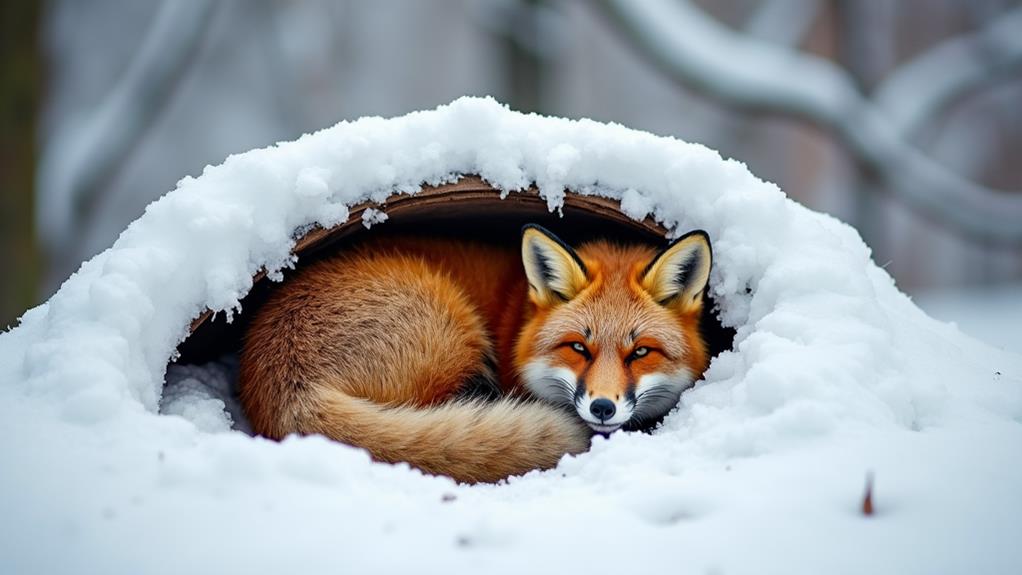
To stay warm during winter, red foxes also master energy conservation practices. They prepare for the cold by building up extra body fat in autumn, which acts as insulation and energy reserves when the temperatures drop.
With their thicker undercoats and longer fur, they've got a cozy winter coat that traps heat, keeping them warm even in severe conditions.
But that's not all! These clever animals make use of a fascinating heat exchange mechanism in their legs, allowing them to retain warmth while frolicking through snowy landscapes—now that's impressive!
When it gets really chilly, you might find a red fox curling up in a tight ball or burrowing into the snow to minimize heat loss.
Their behavioral adaptations are equally remarkable. They typically rest during the coldest parts of the day, preserving energy.
Then, they venture out to forage during those magical twilight hours when their chances of a good meal increase.
Interactions With Environment
How do red foxes interact with their winter environment to survive the cold? These clever little creatures have some neat tricks up their furry sleeves. They don't just rely on their thick coats; they've adapted beautifully to the chilly weather. Here's how they manage:
- Extra insulation: Red foxes grow a super thick undercoat that keeps the warm air trapped next to their skin, perfect for those frosty days.
- Paw power: Their paws grow additional fur, which helps them tackle snowy terrains without losing precious body heat.
- Smart hunting: Instead of chasing after food, foxes listen and walk quietly to locate prey hidden beneath the snow.
These interactions with the environment are essential for their survival. When food gets scarce, foxes cleverly cache extra food in shallow holes, ensuring they've enough energy to last through the winter.
This savvy behavior highlights how they work with nature, adapting their approach and conserving energy. It's like they've got their own little survival toolkit to thrive in the cold! Isn't that just a wild way to keep warm?
Final Thoughts
So, next time you see a red fox darting through the snow like a furry little acrobat, remember all the clever tricks it uses to stay warm. From their cozy coats to snuggling into dens, these wily creatures have winter survival down to an art. They hunt smart, conserve energy, and adapt their behavior, all while looking effortlessly adorable. It's a tough world out there, but red foxes tackle winter with style—and a bit of cunning!


